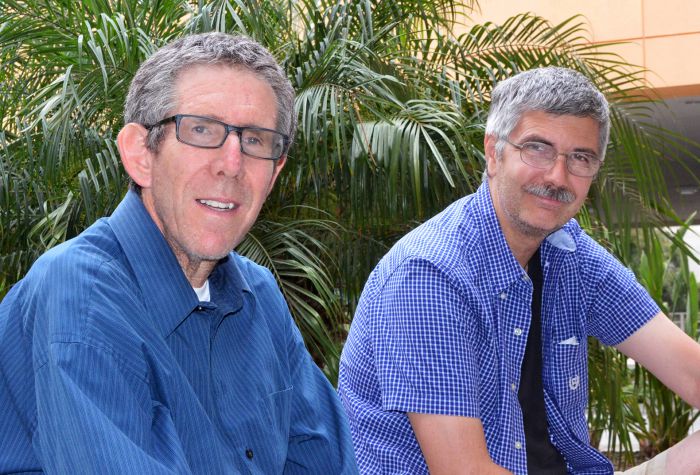
In physics today, adding anything to the “Theory of Everything” (ToEs) would really be something.
That possibility may come true for Ken Ganezer and Jim Hill, professors of physics at California State University, Dominguez Hills (CSUDH), and physics lecturers Brandon Hartfiel and William Keig, who co-authored the study “Search for n−n(bar) oscillation in Super-Kamiokande,” which was published in the peer-reviewed scientific journal Physical Review D in April 2015.
The study is based on years of research conducted in the Super-Kamiokande detector, a nucleon decay and neutrino observatory in Hida, Japan, by the CSUDH faculty, approximately 20 of their students and with the collaboration of scientists in Asia, Europe and Canada.
The study shows an increase in the lower limits of the lifetimes of neutron-antineutron particle oscillations by factors of 3-4 in oxygen atoms–the time it takes a neutron to oscillate to an antineutron. They have yet to observe such oscillations in their research, which implies that at some time during the universe-creating “big bang” ordinary matter must have oscillated to antimatter much more slowly than the reverse process (antimatter to matter). This broaches the question as to why antimatter is so rare in the universe.
“If we raise these limits by another factor, of say 30-100, which may be done in future experiments, we would likely have the sensitivity to prove these leading theories to be wrong, thereby paving the way for new theories of everything [the ‘Theory of Everything’ currently consists of several theories],” said Ganezer. “Or, we might finally see neutron-antineutron oscillation events in our data, rather than during background events, which might show that leading theories of everything are likely correct, or correct in some other predictions.”
Everything from the smallest life forms to the largest objects in the cosmos are made almost entirely of matter. Everything else is energy. If the Big Bang Theory is correct, the event should have created equal amounts of matter and antimatter in the early universe. This phenomena of matter and antimatter creation are thought to have occurred quickly after the big bang as the universe began to cool from 1028 kelvins down to 3,000 kelvins (approximately 4,940 degrees Fahrenheit), according to Hill.
“We have a huge detector [the Super-Kamiokande] with 50,000 tons of ultra-pure water, which is buried a kilometer underground in a mountain in Gifu Prefecture in western Japan. That is a lot of water molecules, and a lot of oxygen nuclei,” said Hill, who is CSUDH’s chair of the Academic Senate. “But since we have not seen neutron oscillations occur in these thousands of tons of neutrons over 30 years of looking, we can be sure that it wouldn’t be likely to be observed by one of us in about a thousand billion billion billion years, on average.”
Along with implications regarding why antimatter is so rare–known as the baryon asymmetry problem–their research also provides data for those who are working to find new theories to fulfil renowned physicist Albert Einstein’s unfinished goal of finding a unified field theory of gravity and electromagnetism, according to Ganezer.
“One of the most important goals of modern physics is to unify the basic laws of physics into a few simple equations,” said Ganezer. “Our findings are important for physics research and physics research planning in the world, including what is going on at the Large Hadron Collider at CERN [the world’s largest and most powerful particle accelerator]. The results in this paper supersede measurements that have not been updated in about 25 years and were not official until this paper was published in April.”
Ganezer first wrote about theories of everything in 1980 at UCLA as a doctorate student working on his Ph.D. in physics.
“One of my professors who specialized in gravity asked me to comment on a new paper on supersymmetry and supergravity. I responded by writing a paper myself on the consistency of supersymmetry and supergravity theory. This was my first physics publication and my first direct experience with theories of everything,” he said. “At the time, I was impressed by the beauty of the equations for supergravity, but I wondered–as did most physicists at that time–how supersymmetry and supergravity could ever be tested experimentally.”
Since the publication of the paper, others have discussed and published pieces with theories and phenomena, such as supersymmetry, similar to those proposed by the CSUDH researchers. Others have also placed constraints on neutron oscillation found at the Super-Kamiokande using the professors’ data.
“The results of our research agree with leading theories and our experimental sensitivity. The fact that this paper has 29 citations seems to indicate that it may have raised interest in this search,” said Ganezer. “This might encourage others to continue the search for neutron oscillations as well as the search more for the Theory of Everything.”